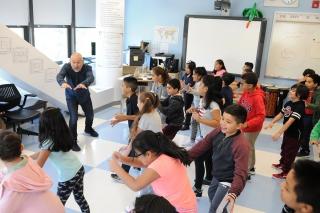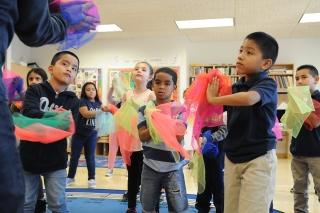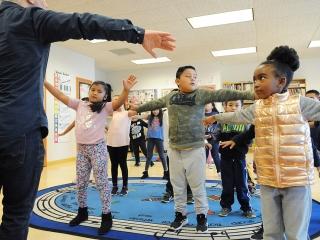The 4th-graders karate-chop and chicken-walk their way like flashing swords through the exuberant parts of Aram Khachaturian’s “Sabre Dance.” Then they slow down and tiptoe silently through the quieter sections of the music. The students love every minute of it, with everyone totally engaged and immersed in a 19th-century classic they will later discuss.
In Evan Alboum’s music class at PS 305 in Ridgewood, Queens, students at every grade level learn to know and appreciate classical music through all their senses. Alboum wants his students to know music on a deep level, “kinesthetically,” so he begins the study of each piece of classical music with movement he choreographs. He fully participates with each class.
“Music is moving and I use it to teach rhythmic motives,” he said. “All our clapping, snapping, patting and stomping is about learning meter.”
With arms extended and hands palm to palm, Alboum softly sings directions to a group of 2nd-graders — smooth, smooth, glide, dip — as they mime fish swimming to a recording of the Aquarium movement from the humorous musical suite “The Carnival of the Animals” by Camille Saint-Saëns. With the music in the background and a big-screen video of fish moving in an aquarium, the children quickly overcome their self-consciousness and begin very naturally weaving through the waves, quickly or slowly as the tempo of the music dictates and up and down reflecting high and low notes.
Students take turns at a xylophone setting tempo and direction by playing ascending notes for tiptoes and descending notes for crouching. And they add brightly colored squares of gauze to their hands to create a sense of the fishes’ colorful gills. In a follow-up lesson, they will all play on xylophones, learning how to improvise music with ascending and descending melodic lines.
“Learning through multiple senses helps students’ learning beyond the music room,” said teacher Nese Yilmaz, watching her 2nd-grade class swim around the room and talk about the music. “They continue to build on stamina, develop vocabulary, strengthen the use of technology, improve movement and build self-esteem.”
A former performer, Alboum did a one-man show playing all the parts in Gilbert and Sullivan operettas, as well as physical comedy at the piano. He brings that energy and creativity into the classroom.
“Bugs Bunny is the crown jewel of physical comedy with classical music and the most important influence on how I came to do what I do,” he said.
Movement is Alboum’s way to motivate students, but it isn’t long before he has them talking about the music and reading about the composers.
“Who is this guy W. A. Mozart?” was the way Alboum posed a challenge to 3rd-graders, who had interpreted the music through the choreography he had created for the lively overture to Mozart’s opera, “The Marriage of Figaro.” Seated in a circle and catching their breath afterward, students supplied adjectives and singled out instruments to describe the moods of the piece and then moved into small groups, each reading a section of a Mozart biography. By the end of the lesson, each group had generated a question — Why did he make music that was both sad and funny? When did he write the music we heard? — all to be answered in future class discussions.
Alboum puts a premium on getting students, especially the school’s many students who are recent immigrants, talking about the music to strengthen their understanding, vocabulary and communication skills.
In a classroom filled with bright posters about all things musical, Alboum leads students through large musical maps of each piece so they understand the pattern and structure of the music they have listened to, moved to and talked and read about. He is always ready to illustrate a point at the piano or on xylophone, guitar or drums.
Beyond the classroom, Alboum, who has been at PS 305 for seven of the 12 years he has been teaching, leads the school chorus, has written musicals for the school’s student productions and is looking forward to serving as musical director for the 5th- and 6th-grade production of “The Lion King” in May.
Fourth-graders, exhilarated by their Khachaturian karate chops, were happy to hear about upcoming keyboard classes. As they left the room, the last one out said, over his shoulder, “I remember Mozart.”


